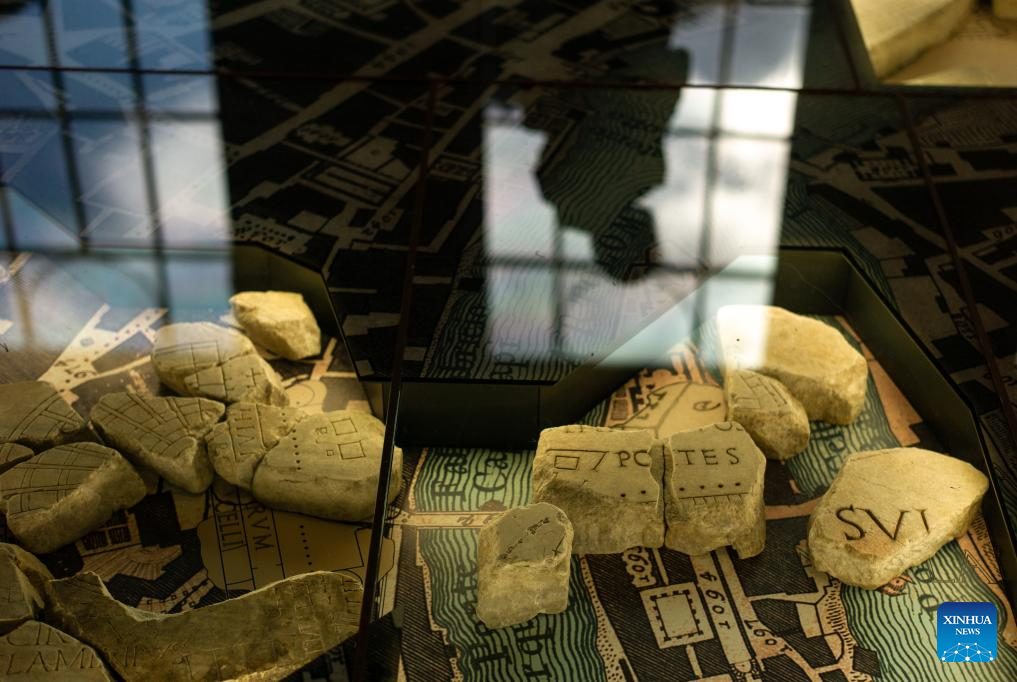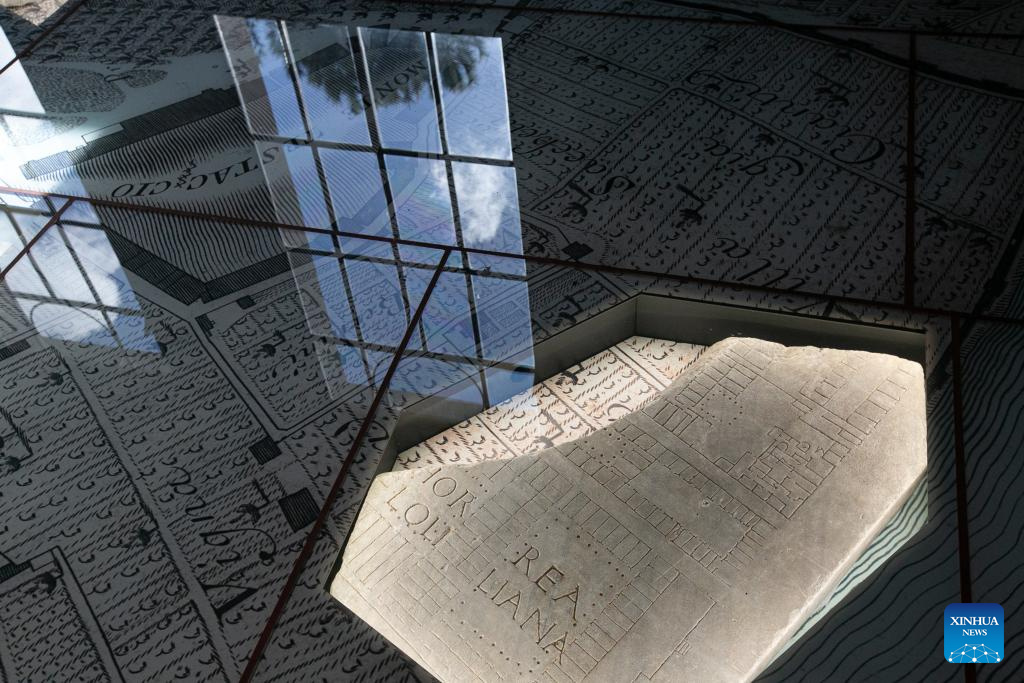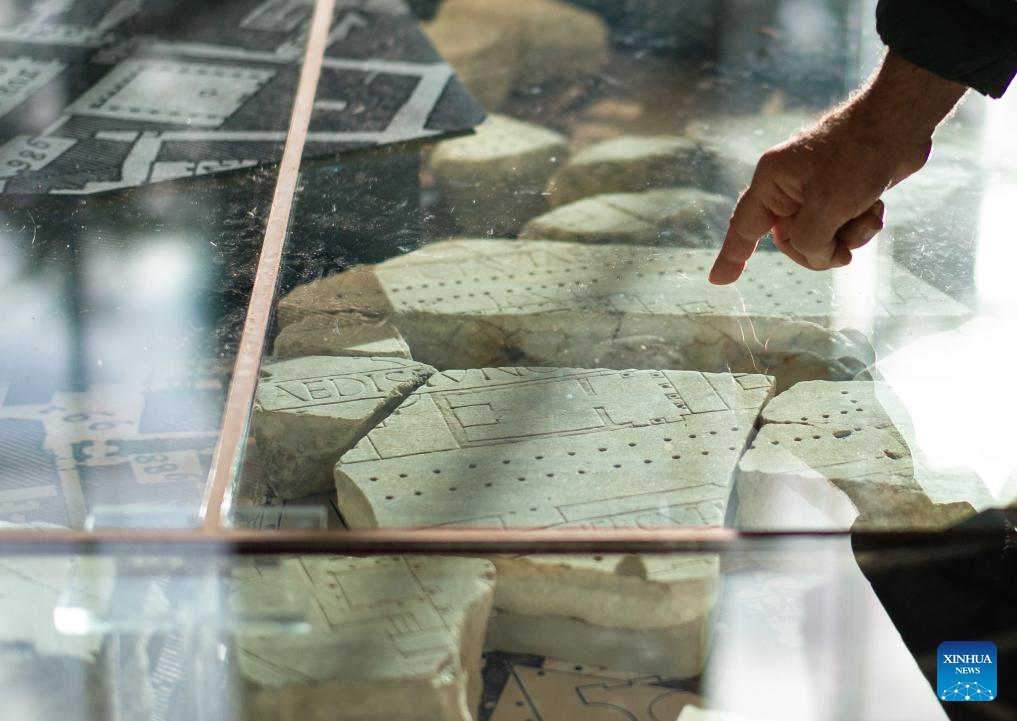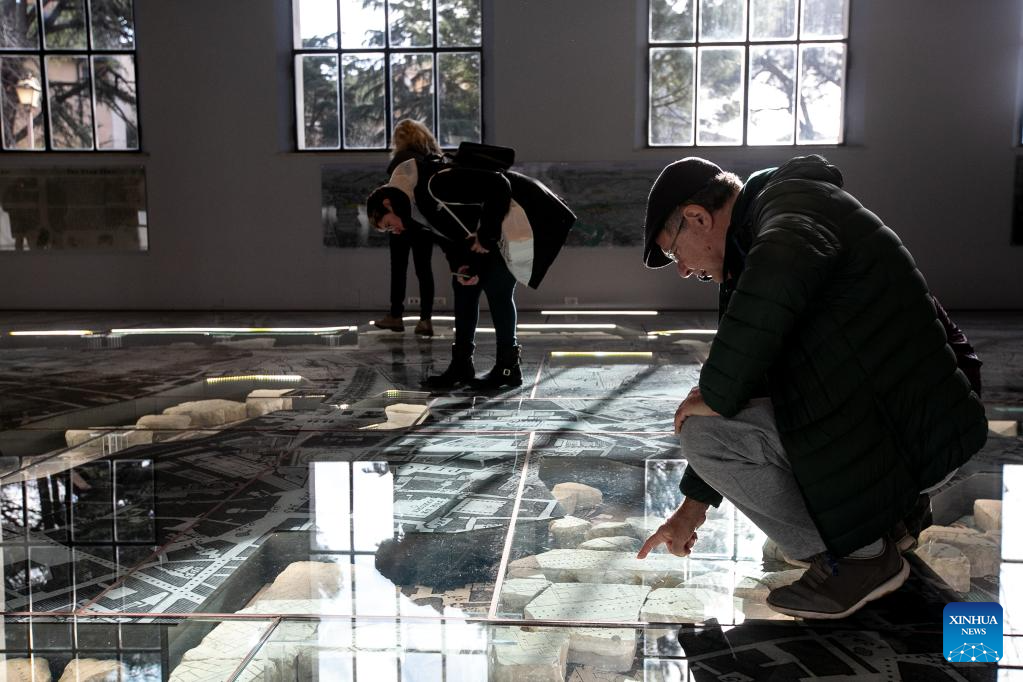
Fragments of the marble map of the ancient Rome are seen the Museum of Forma Urbis in Rome, Italy, Jan. 16, 2024. The Museum of the Forma Urbis, enclosed within a new archaeological park, opened to the public recently. The museum houses the remaining fragments of the Forma Urbis Romae, the giant marble map of ancient Rome engraved between 203 and 211 AD. Epigraphic and architectural artifacts are showcased within the archaeological park, providing free access for both citizens and tourists. (Xinhua/Li Jing)

A visitor looks at fragments of the marble map of the ancient Rome in the Museum of Forma Urbis in Rome, Italy, Jan. 16, 2024. The Museum of the Forma Urbis, enclosed within a new archaeological park, opened to the public recently. The museum houses the remaining fragments of the Forma Urbis Romae, the giant marble map of ancient Rome engraved between 203 and 211 AD. Epigraphic and architectural artifacts are showcased within the archaeological park, providing free access for both citizens and tourists. (Xinhua/Li Jing)

A fragment of the marble map of the ancient Rome is seen at the Museum of Forma Urbis in Rome, Italy, Jan. 16, 2024. The Museum of the Forma Urbis, enclosed within a new archaeological park, opened to the public recently. The museum houses the remaining fragments of the Forma Urbis Romae, the giant marble map of ancient Rome engraved between 203 and 211 AD. Epigraphic and architectural artifacts are showcased within the archaeological park, providing free access for both citizens and tourists. (Xinhua/Li Jing)

A visitor looks at fragments of the marble map of the ancient Rome in the Museum of Forma Urbis in Rome, Italy, Jan. 16, 2024. The Museum of the Forma Urbis, enclosed within a new archaeological park, opened to the public recently. The museum houses the remaining fragments of the Forma Urbis Romae, the giant marble map of ancient Rome engraved between 203 and 211 AD. Epigraphic and architectural artifacts are showcased within the archaeological park, providing free access for both citizens and tourists. (Xinhua/Li Jing)

A visitor points at the fragments of the marble map of the ancient Rome in the Museum of Forma Urbis in Rome, Italy, Jan. 16, 2024. The Museum of the Forma Urbis, enclosed within a new archaeological park, opened to the public recently. The museum houses the remaining fragments of the Forma Urbis Romae, the giant marble map of ancient Rome engraved between 203 and 211 AD. Epigraphic and architectural artifacts are showcased within the archaeological park, providing free access for both citizens and tourists. (Xinhua/Li Jing)

Visitors take a tour in the Museum of Forma Urbis in Rome, Italy, Jan. 16, 2024. The Museum of the Forma Urbis, enclosed within a new archaeological park, opened to the public recently. The museum houses the remaining fragments of the Forma Urbis Romae, the giant marble map of ancient Rome engraved between 203 and 211 AD. Epigraphic and architectural artifacts are showcased within the archaeological park, providing free access for both citizens and tourists. (Xinhua/Li Jing)

Visitors take a tour in the Museum of Forma Urbis in Rome, Italy, Jan. 16, 2024. The Museum of the Forma Urbis, enclosed within a new archaeological park, opened to the public recently. The museum houses the remaining fragments of the Forma Urbis Romae, the giant marble map of ancient Rome engraved between 203 and 211 AD. Epigraphic and architectural artifacts are showcased within the archaeological park, providing free access for both citizens and tourists. (Xinhua/Li Jing)

Visitors take a tour in the Museum of Forma Urbis in Rome, Italy, Jan. 16, 2024. The Museum of the Forma Urbis, enclosed within a new archaeological park, opened to the public recently. The museum houses the remaining fragments of the Forma Urbis Romae, the giant marble map of ancient Rome engraved between 203 and 211 AD. Epigraphic and architectural artifacts are showcased within the archaeological park, providing free access for both citizens and tourists. (Xinhua/Li Jing)

Visitors take a tour in the Museum of Forma Urbis in Rome, Italy, Jan. 16, 2024. The Museum of the Forma Urbis, enclosed within a new archaeological park, opened to the public recently. The museum houses the remaining fragments of the Forma Urbis Romae, the giant marble map of ancient Rome engraved between 203 and 211 AD. Epigraphic and architectural artifacts are showcased within the archaeological park, providing free access for both citizens and tourists. (Xinhua/Li Jing)

Visitors take a tour in the Museum of Forma Urbis in Rome, Italy, Jan. 16, 2024. The Museum of the Forma Urbis, enclosed within a new archaeological park, opened to the public recently. The museum houses the remaining fragments of the Forma Urbis Romae, the giant marble map of ancient Rome engraved between 203 and 211 AD. Epigraphic and architectural artifacts are showcased within the archaeological park, providing free access for both citizens and tourists. (Xinhua/Li Jing)



